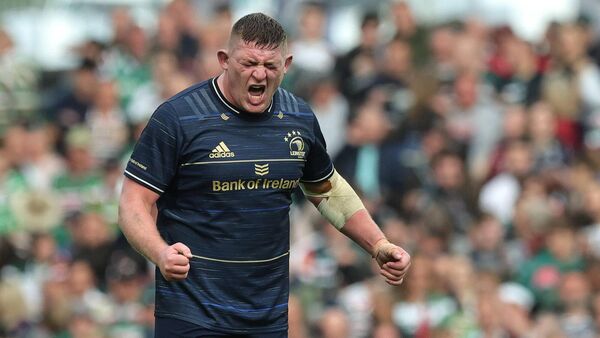Munster aren’t in the habit of doing favours for Leinster but the 100 minute assault they subjected Toulouse to the weekend before last did the men in blue no harm on Saturday.
While it was not the main reason for Leinster outclassing their opponents so comprehensively, it was clear that coming back to Dublin a week after such a battle was a bridge too far for a Toulouse side that was made to look flat, lifeless and pedestrian.
It would be foolish to concentrate on this, however, at the expense of picking through what was one of Leinster’s best performances in recent years. In the first half in particular, they made the French and European champions look like many of the quintessentially French sides we have seen playing against better opposition in Europe over the years: big, unfit, ill-disciplined and simply unable to cope with the sustained pressure that was thrown at them.
From the opening minutes, Toulouse were like putty in Leinster’s hands. They moved them from side to side, created and exposed fractures in defence, and were ruthlessly clinical in everything they did. Leinster were operating on a different level in virtually every facet of the game and looked very much like a side that will take home the trophy at the end of the month.
But what makes Leinster so good? We know the obvious stuff: physicality, work rate, execution, and so on. While these have meaning, they often become buzzwords that are bandied about to explain performances without examining them in the forensic detail they deserve.
If I had to pick one area that separates Leinster from the rest, it is how well their forwards execute their general phase play attack. We are all familiar with the various options a pod of three forwards has when they receive the ball off 9 or 10. In addition to carrying themselves, they can pop it to the man outside or pull it back to a player sitting behind the pod.
This has become a staple of nearly every attacking system in professional rugby in the last decade but like everything in sport, the standard at which it is done varies drastically from team to team. This is particularly true for the pull back option. Pretty much everyone is able to catch the ball and pass it behind them; if you can’t do that, you probably don’t have much business playing pro rugby. Doing it really well isn’t quite as straightforward.
What you see a lot of guys do is take it standing, move laterally if at all, and immediately turn their outside shoulder 90 degrees to get an early eye of the player behind, to minimise the chances of getting the pass wrong. This does very little to challenge the defence. Because the player doesn’t advance with the ball, it’s clear he is not a carrying option. Because he turns his shoulders so early, it is also clear he won’t be popping the ball to the man on his outside.
As soon as the defence sees the carrier do this, it’s obvious he will only be giving the ball out the back. The defence can then push off immediately without any threat to the integrity of the line and concentrate on supporting the inside shoulders of the wider defenders. Leinster aren’t content to do this. As with every element of their game, they do it the best way it can possibly be done.
The purpose of this ‘micro-play’, as it is known, is to ensure the three options – carry, pop outside or pull back – are a real threat every single time. When done properly, it forces the defence to respect the pod of forwards and ultimately make a read on whether to bite in or push off to get to the option out the back.
Watching Leinster do this on Saturday was like watching a best practice reel at a coaching seminar. To a man, they accelerated with the ball and stayed square to force the defenders to sit down. When they pulled the ball back, it was done right on the gain line, just before they were hit and often without even looking. This directly led to line breaks, penalties and tries all afternoon. Two men in particular showed how it should be done.
Ross Molony did it better than anyone throughout the game. Every budding coach should repeatedly watch him execute the pull back to perfection in the build up to Van der Flier’s 19th minute try. He receives the ball from Gibson-Park, accelerates three big, powerful steps straight at the man in front and pulls it back to Sexton just before he gets hit.
Toulouse tighthead Aldegheri makes an incorrect read, biting in on James Ryan who is running the line on Molony’s outside shoulder. This allows Sexton to beat him on the outside, sell Rory Arnold the dummy and sever the line before feeding Van der Flier to finish.
Tadhg Furlong also gave a handling exhibition, as he so often does, receiving the ball at pace on the gainline and giving the softest of passes milliseconds before he gets hit. Despite only playing 17 minutes, he had multiple deft touches and the way he opened up the Toulouse defence on the nine minute mark highlighted the uncertainty you can create by running this micro-play really well.
On this occasion, he receives the ball off Sexton with Doris outside and Keenan out the back. He keeps the ball in two hands and stays square as he always does. This invites Toulouse number eight Jelonch to bank on the ball going to Keenan behind the pod, as had already happened many times in the opening exchanges.
Jelonch makes the wrong call and drifts off to take Keenan, leaving a huge gap on Furlong’s outside shoulder which he spots and puts Doris through with a pop. Had Doris been more forgiving with his pass to Keenan after breaking the line, it would have been a beautiful try. This is the kind of chaos you can create by doing something simple better than other teams. Even against the reigning European champions.
Molony was my standout performer of the day. Much like Billy Holland at Munster, he has had to be patient over the years, playing an important role in the squad but living somewhat in the shadow of big and emerging names like Toner, Ryan and Baird. Prior to this season, he had started just two European Cup games.
He has started all seven of this campaign, playing 80 minutes in all but one, calling lineouts and getting through enormous work on both sides of the ball. I have lost count of the number of conversations I’ve had with Leinster fans who saw the second row as a big weakness in the last couple of years, saying the personnel were too light to compete with the likes of Toulouse and La Rochelle.
It’s great having a guy like 145kg Emmanuel Meafou in your ranks but once his carrying threat is neutralised like it was at the weekend, the advantage disappears. I would much rather an athletic, mobile second row partnership that can hold its own physically but sustain a much higher intensity over the course of the game, on top of having the handling skills to fulfil a playmaking role when needed.
During the dire display we were treated to on Sunday between Racing and La Rochelle, many were commenting online that neither team would threaten Leinster based on the respective performances over the weekend. Basing the outcome of a final on one outing is foolish and Leinster will obviously not fall into that trap.
While La Rochelle are still the well-oiled machine they were last season, Leinster are in a different place and won’t be bullied up front the way they were in last year’s semi-final. With the form they are in, individually and collectively, I’ll be surprised if they fail to clinch their fifth European title later this month.

